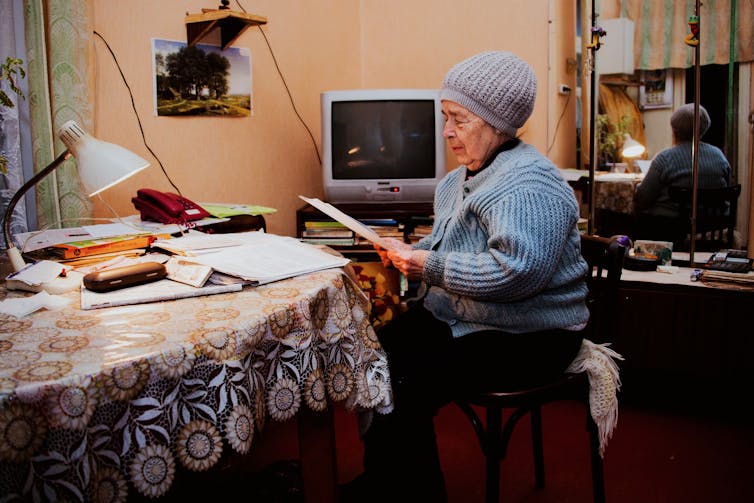Source: The Conversation (Au and NZ) – By Magdalena Plebanski, Professor of Immunology, RMIT University

Influenza, or the flu, is a virus transmitted by respiratory droplets from coughing and sneezing. It can cause the sudden onset of a fever, cough, runny nose, sore throat, headache, muscle and joint pain.
In Australia, the flu is responsible for more than 5,000 hospitalisation and 100 deaths a year. The highest rates are among those over 65, whose immune systems aren’t as effective as they used to be, and children under five, whose immune systems are yet to mature.
To combat the decline in immunity as we age, specific vaccines are available for people aged 65 and over. So how do they work, and why exactly are they needed?
À lire aussi :
Should I get a flu vaccine this year? Here’s what you need to know
Remind me, how does the immune system work?
The immune system uses multiple mechanisms to fight viral infections, which can be divided into two major arms of the immune system, called innate and adaptive immunity.
Innate immunity involves multiple inflammatory cells and chemicals that are triggered immediately, or within hours of encountering an infection. They activate the immune system to clear the infection.
Adaptive immunity takes a little longer (weeks) to work and involves memory T cells and antibody-producing B cells, which can be reactivated when the body encounters a virus or other pathogen.
The combined innate and adaptive immune response determines how well we respond to an invading virus like influenza.
Why are older people more at risk from the flu?
Generally, as we age past 65, the innate cells become less effective at their job of clearing infections. They also start producing more inflammation.
New T and B cell numbers also decrease with increasing age and hence the adaptive immune response is also not as effective as when we are younger. This immune system decline is called immunosenescence, which leads to increased susceptibility, hospitalisation and death from influenza.

Mariia Chalaya/Unsplash
Certain medical conditions, such as cancer and heart and lung conditions, increase susceptibility to severe influenza, with older people being more likely to have additional medical conditions than younger people.
What flu vaccines are available?
Annual flu vaccines are recommended to protect against the common circulating strains of influenza, which can differ from year to year.
The standard flu vaccines offered to adults aged under 65 consist of surface proteins of the virus or inactivated (killed) virus from four influenza strains: two A strains (H1N1 and H3N2) and two B strains.
When you’re vaccinated, your immune system makes antibodies from B cells which protect you if you become exposed to these strains of the virus.
However, the standard influenza vaccine is less effective in older people.

Katarzyna Grabowska
Two stronger or augmented vaccines have been made targeting this age group. They contain the same components as the standard vaccine, but one vaccine – called Fluad – uses a strong adjuvant (an agent used to increase the immune response to vaccination) called MF59 to stimulate better immunity.
The other augmented vaccine, called Fluzone, uses a four-fold higher dose of each influenza strain to increase immunity.
À lire aussi :
Why can you still get influenza if you’ve had a flu shot?
How do they compare?
Studies comparing Fluad and Fluzone show both vaccines stimulate stronger immunity against influenza than the standard flu vaccine and are therefore likely to provide better protection.
Studies directly testing for improved clinical outcomes with vaccines for over-65s show a small benefit of receiving either of the vaccines over the standard vaccine, including a modest decrease in lab-confirmed influenza, hospitalisations and emergency department visits compared to the standard influenza vaccine.
They are however yet to show and impact on flu-related deaths.

Raychan/Unsplash
In the few studies comparing Fluad and Fluzone directly, there is little evidence of a difference between them in reducing influenza and serious flu outcomes. The Australian Technical Advisory Group on Immunisation therefore recommends using either Fluad or Fluzone.
While both have been Therapeutic Goods Administration (TGA) approved since 2020, only Fluad is available for free on the National Immunisation Program for people aged 65 and over.
Fluzone is only available with a private prescription if you’re 60 years and over, at a cost of around A$65-70.
If neither augmented vaccine is available, a standard influenza vaccine is also acceptable for older people, since any influenza vaccine is preferable to receiving none.
Flu vaccines can also be given at the same time as COVID vaccines.
How else can we protect against the flu?
While influenza vaccination is the single most effective way of preventing influenza, other measures such as social distancing and wearing a mask or N95 respirator can also provide some community protection.
Wearing a mask or N95 respirator significantly reduces the risk of infecting others when infected.
The evidence for protecting oneself against infection is less conclusive, mainly because it’s linked to early, consistent and, importantly, the correct use of masks.
À lire aussi :
Over half of eligible aged care residents are yet to receive their COVID booster. And winter is coming
![]()
Magdalena Plebanski receives Grant funding from National Health and Medical Research Council (NHMRC) to conduct fundamental immunology research on Flu and DTP vaccines in older adults. She conducts research on ovarian cancer, including a Phase II human trial part funded by Astrazeneca and ANZGOG (Australia and New Zealand Gynecological and Oncological Group).
Katie Louise Flanagan receives funding from NHMRC, MRFF, BMGF and Clifford Craig Foundation. She was previously on Vaccine Advisory Boards for Seqiris (2016-19) and Sanofi-Pasteur (2016-18). She is President of the Australasian Society for Infectious Diseases and a member of the Australian Technical Advisory Group on Immunisation. These are her own personal views.
Jennifer Boer et Kirsty Wilson ne travaillent pas, ne conseillent pas, ne possèdent pas de parts, ne reçoivent pas de fonds d’une organisation qui pourrait tirer profit de cet article, et n’ont déclaré aucune autre affiliation que leur poste universitaire.
– ref. I’m over 65 and worried about the flu. Which vaccine should I have? – https://theconversation.com/im-over-65-and-worried-about-the-flu-which-vaccine-should-i-have-204810








